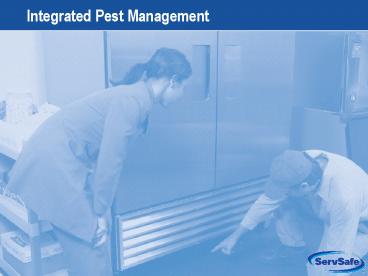Integrated Pest Management - PowerPoint PPT Presentation
1 / 16
Title:
Integrated Pest Management
Description:
Integrated Pest Management Apply Your Knowledge: Test Your Food Safety Knowledge Integrated Pest Management An Integrated Pest Management (IPM) program: Uses ... – PowerPoint PPT presentation
Number of Views:229
Avg rating:3.0/5.0
Title: Integrated Pest Management
1
Integrated Pest Management
2
Apply Your Knowledge Test Your Food Safety
Knowledge
- True or False A strong oily odor may indicate
the presence of cockroaches - True or False The main purpose of an integrated
pest management program is to control pests once
they have entered the establishment - True or False Stationary equipment should not be
covered before applying pesticides since it gives
pests a place to hide - True or False Glue traps are used to prevent
cockroaches from entering the establishment - True or False Pesticides can be stored in food
storage areas if they are closed tightly and
properly labeled
13-2
3
Integrated Pest Management
- An Integrated Pest Management (IPM) program
- Uses prevention measures to keep pests from
entering the establishment - Uses control measures to eliminate any pests that
get into the establishment - Will be successful if you work closely with a
licensed pest control operator (PCO)
4
The Three Rules of IPM
- The Three Rules of Integrated Pest Management
- Deny pests access to the establishment
- Deny pests food, water, and shelter
- Work with a licensed PCO to eliminate
pests
that do enter
5
Denying Pests Access to the Establishment
- To keep pests from entering with deliveries
- Use reputable suppliers
- Check deliveries before they enter the
establishment - Refuse shipments if you find pests or signs of
infestation (egg cases, body parts)
6
Denying Pests Access to the Establishment
- To keep pests from entering through openings in
the building - Screen windows and vents
- Install self-closing devices, door sweeps,
and air curtains on doors - Keep exterior openings closed tightly
- Fill holes around pipes
- Cover drains with grates
- Seal cracks in floors, walls, and around
equipment
7
Denying Pests Food and Shelter
- To deny pests food and shelter
- Dispose of garbage quickly
- Clean up spills around containers immediately
- Keep containers clean and tightly covered
- Store recyclables properly
- Keep recyclables in pest-proof containers
- Keep containers as far away from the building as
regulations allow
8
Denying Pests Food and Shelter
- To deny pests food and shelter continued
- Store food and supplies quickly and properly
- Keep them away from walls and at least 6 (15 cm)
off the floor - Rotate products so pests cannot settle and breed
- Clean the establishment thoroughly
- Clean up food and beverage spills immediately
- Clean break rooms after use
- Keep cleaning tools and supplies clean and dry
9
Grounds and Outdoor Dining Areas
- To protect outdoor customers from pests
- Mow grass, pull weeds, remove standing water, and
pick up litter - Cover outdoor garbage containers
- Remove dirty dishes and uneaten food from tables
and clean them quickly - Do not allow people to feed wildlife
- Locate electronic insect eliminators (zappers)
away from food and serving areas - Call the PCO to remove hives and nests
10
Identifying Pests Cockroaches
- Cockroaches
- Carry bacteria, viruses, and parasite eggs
- Live and breed in places that are
- Dark
- Moist
- Hard-to-clean
- If you see them in daylight, you may have a
major infestation
Illustration courtesy of Orkin Commercial
11
Identifying Pests Cockroaches
- Signs of a cockroach infestation include
- A strong oily odor
- Droppings similar to grains of pepper
- Capsule shaped egg cases
- Brown, dark red, or black
- Leathery, smooth, or shiny
Illustration courtesy of Orkin Commercial
12
Identifying Pests Rodents
- Signs of a rodent infestation include
- Signs of gnawing
- Droppings
- Shiny and black (fresh)
- Gray (old)
- Tracks
- Nesting materials
- Paper, cloth, hair, feathers or grass
- Holes
- In quiet places
- Near food and water
- Next to buildings
Illustration courtesy of Orkin Commercial
13
How to Choose a PCO
- Before choosing a PCO
- Talk to other foodservice managers
- Make sure the PCO is licensed or certified
- Ask the PCO if they belong to any professional
organizations - Ask for proof of insurance
- Weigh all factors, not just price
14
Working with a Pest Control Operator (PCO)
- Your PCO should
- Help you develop an integrated approach to pest
management - Stay up-to-date on new equipment and products
- Provide prompt service to address
problems as they occur - Keep records
15
Using and Storing Pesticides
- When pesticides will be applied
- Wait until you are closed for business and
employees are offsite - Remove food and movable food-contact surfaces
- Cover equipment and immovable food-contact
surfaces - Afterwards
- Wash, rinse, and sanitize food-contact surfaces
16
Using and Storing Pesticides
- If pesticides will be stored on the premises
- Keep them in their original containers
- Lock them in cabinets away from areas where food
is prepared and stored - Store aerosol or pressurized spray cans in a cool
place - Dispose of them as per local regulations
- Keep corresponding MSDS on the premises































